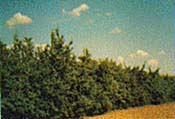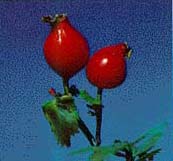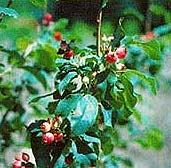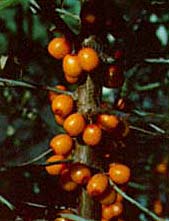| Français | Contact Us | Help | Search | Canada Site | |||||
| AAFC Online | Links | Newsroom | What's New | Site Index |
| PFRA Online | Staff | Programs & Services | Offices | ||||
Prairie Farm Rehabilitation Administration |
||||||||
 |
||||||||
|
Buffaloberry
Bur Oak Black-fruited Choke Cherry Red-osier Dogwood Hawthorn Red Elder Hedge Rose Russian Olive Saskatoon Sea-buckthorn Siberian Crabapple |
|
Trees and shrubs for wildife habitat plantingsThe PFRA Shelterbelt centre grows and distributes a number of trees and shrub species for wildlife habitat plantings. The following are recommended species, their requirements and uses in wildlife planting. Buffaloberry(Shepherdia argentea Nutt.)
Buffaloberry is native of the southern parts of western Canada and is found growing naturally in river valleys and around sloughs. Although it prefers moist well drained sites, it will tolerate some spring flooding and is drought hardy. Buffaloberry is tolerant to saline and alkaline soils. 
Buffaloberry is a bushy,tall shrub that grows to height of 4 to 5 metres. This shrub species suckers and forms a dense irregular hedge. The lateral branches have sharp spines at the tip and are formed at right angles to the main branch. The leaves are silvery on both sides. The small yellow flowers, appearing in late June or early July, are borne in clusters along stems. The buffaloberry produces male and female flowers on seperate plants; only the female plants bear fruit. Fruit ripens in July and August and varies from scarlet to orange in colour. Uses for WildlifeThe fruit is an important winter food for game birds and other species - such as waxwings - that remain for the winter. The buffaloberry's suckering habit creates excellent edge cover and also assures continuation of the species. The shrub is of minor importance as a browse species. Bur Oak (Quercus macrocarpa Michx.)Bur oak is a hardy, long-lived tree that is adapted to a wide range of soils. Under favorable conditions, it may attain a height of 15 to 20 metres but on dry sites it is reduced to a small scrubby tree. A taprooted species, the bur oak takes a few years to establish after transplanting but will grow at a moderate rate thereafter.
The bark is gray and flaky, becoming deeply furrowed as the tree matures. Branches often have corky ridges or wings. The leaves are dark, shiny green above, grayish white and slightly wooly beneath, and are deeply cut with rounded lobes. The fruit is an acorn, 2 to 2.5 cm long, resting in a shallow fringed or "mossy" cup. Uses for WildlifeThe bur oak provides a staple food for jays, flickers and chipmunks. Game birds such as wild turkey, ruffed grouse and wood duck use bur oak for cover as well as food. Mule and whitetail deer browse the twigs and foliage and eat the acorns. Black-fruited Choke Cherry (Prunus virginiana L. Var Melanocarpa [A. Nels.] Sarg.)Choke cherry is a native shrub or small tree that occurs throughout the Prairie provinces. It is commonly found bordering bluffs, particularly on the south side, and along fencelines and riverbanks. Although choke cherry is moderately drought hardy, it performs best in a moist, well-drained location. 
Choke cherry has a moderate growth rate and under favorable conditions, it will reach a height of 7 metres in 20 to 25 years. It thrives under good light conditions and suckers readily. Flowers appear the first part of June in long drooping clusters at the ends of branches. The fruit matures from late July to early September. Uses for WildlifeChoke cherry fruit is relished by sharp-tailed and ruffed grouse and songbirds such as grosbeaks, jays and waxwings. The twigs and foliage are browsed by whitetail and mule deer. Red-osier Dogwood (Cornus stolonifera Michx.)
Red-osier dogwood is a shrub native to the Prairies and is commonly found in woodlands, coulees and along water courses. A fast growing shrub, dogwood is adapted to both wet and dry sites and a wide range of soil types. This shrub will grow 1 to 3 metres in height and has reddish branches that make it conspicious in winter. White flowers which appear in flat-topped clusters in early June are followed by white berries. Uses for WildlifeProvision of dense cover is its main value to wildlife. Dogwood is a preferred browse species of deer and rabbits.The fruit provides summer food for robins, cedar waxwings and game birds. Hawthorn (Crataegus sp.)Native across Canada, there are many species of hawthorn and their characteristics vary considerably. Hawthorn is a wide spreading, bushy tree bearing stout thorns on its branches and stems. Although it prefers a rich, moist well drained soil, hawthorn will grow almost anywhere and is often found on the slopes of coulees, in river valleys and in open woods.
Hawthorn can range from 1.5 to 7.5 metres in height, depending on the species. White flowers in showy clusters are borne on the tips of branches in spring. The fruit resembles a small apple, is red to reddish-brown or black at maturity and often remains on the tree during winter. Hawthorn is susceptible to cedar apple rust and also to pear slug infestations in early August. Hawthorn is hard to establish on dry sites. Uses for WildlifeThe fruit is consumed by song and game birds, while the leaves and shoots provide forage for deer and rabbits. Hawthorn is an important species in the habitat for rutted grouse, brown thrashers, robins and mourning doves to rear their young. The thorny branches are a deterrent to nest redators. Red Elder (Sambucus racemosa L.)Red elder is a low-growing deciduous shrub that is native to the Prairies. It thrives in moist conditions and tolerates saturated soils but is not drought resistance. Native stands are found in abundance in moist areas on the Prairies.
Red elder is a fast growing, dense species reaching a height of 3 to 4 metres. It propagates readily from seed as well as from root suckers and layering of branches. The flowers are creamy white and borne in terminal clusters and the fruit that follows is bright red and conspicuous. Uses for Wildlife:The berries provide food for songbirds, upland game birds and squirrels. It is of minor importance as a browse species. Hedge Rose (Rosa rugosa Thunb.)
Hedge rose, a thicket-forming deciduous shrub, was introduced to Canada from Asia. It is well adapted to our climate and to a wide range of soil types. The hedge rose may reach a height of 2 metres. The stems are stout, spiny and hairy. The flowers are solitary, ranging in color from purple to white, and are produced abundantly over a long season beginning in June. The fruit, often called a hip, is oblong, 2 to 2.5 em in diameter and brick red in color. Uses for Wildlife:The hedge rose provides excellent nesting, loafing and winter cover for many thicket-dwelling birds. The rose hip is a favored food of sharp-tailed grouse and pheasants, and the shrub is browsed by whitetail and mule deer. Russian Olive (Eleagnus angustifolia L.)Not available through the PFRA Shelterbelt CentreRussian olive is a shrub or small tree that is a native of Eurasia.In western Canada, it has occassionally spread from cultivation to the wild. It is drought hardy and tolerant to alkaline soils but is susceptible to stem canker disease.
Russian olive is not a long-lived species on the Prairies. Russian olive will reach a height of 7 metres in its 10 to 20 year life span. Both thorny and thornless types of the species exist. Branchlets are silvery in color while the older wood is reddish-brown. The long, narrow leaves are produced in small clusters on twigs in early summer. The silver colored fruit is drupe-like, containing a large seed. 
Uses for Wildlife:Russian olive provides excellent cover and protection for partridge, pheasant and sharp-tail grouse. The fruit provides fall and winter food for songbirds, pheasants, cedar waxwings and sharp-tail grouse. Since it grows rapidly, it provides protection early in new plantings. It has little value as a browse species. Saskatoon (Amelanchier alnifolia Nutt.)Not available through the PFRA Shelterbelt Centre
Saskatoon is a native shrub or small tree, common in coulees, bluffs and open woodlands throughout the Prairie provinces. It grows well on a wide variety of soils and there is some evidence that it is moderately tolerant to salinity. The saskatoon is also drought tolerant once established, and thrives in both sunny and partially shaded sites. Saskatoon is fairly slow growing and will reach a height of 2 to 3 metres at maturity. It propagates by seed, root sprouts and also by stolons, forming colonies. White flowers appear early in the season and the fruit, purple and berry-like, usually ripens in July. Limitations of saskatoon include numerous insect and disease problems such as cedar apple rust. As well, the species is difficult to establish. Uses for Wildlife:Saskatoon provides cover, nesting and roosting for several bird species. Saskatoon berries are sought by numerous song and game birds as well as whitetail and mule deer. Rabbits browse the twigs. Sea-Buckthorn (Hippophae rhamnoides L.)
Sea-buckthorn was introduced from Eurasia and is sometimes found naturalized in the wild. This shrub or small tree is drought resistant and well adapted for growth on sandy soil and steep slopes. It also possesses some tolerance to salinity. Sea-buckthorn will reach a height of 2 to 5 metres and has a tendency to sucker if the roots are injured. Male and female flowers are produced on separate plants. Both are required in a stand for fruit production. 
The branches are grey and spiny with silvery-white leaves. Small yellowish flowers appear in spring before the leaves and attractive yellowish-orange berries follow. The berries remain on the tree through winter. Uses for Wildlife:Deer browse seabuckthorn and the fruit is an important source of winter food for pheasants and other game birds. Siberian Crabapple (Malus baccata [L.] Borkh.)
Siberian crabapple is a vigorous, winter and drought hardy tree. It was introduced into Canada, and it is well adapted to a wide range of soils and climatic conditions. The tree has a large spreading crown and may reach a height of 7 to 9 metres given favorable conditions. White showy flowers are produced in early spring and the tree bears small, berrylike red or yellow fruit later in the season. Siberian crabapple is susceptible to fire blight and does not compete well with weeds. Uses for Wildlife:The dense growth form of the Siberian crabapple provides high quality cover for roosting, loafing and nesting birds. This species is important to many song and game birds and squirrels, as the fruit is usually maintained well into the winter. Rabbits, whitetail and mule deer browse this species. At a time when soil conservation is becoming important ot he value of land, wildlife habitat plantings can provide additional benefits to the landowner. A multiuse land concept that incorporates water and snow conservation, soil erosion control and crop protection with wildlife conservation may be considered. By choosing tree and shrub species that produce berries, fruit or seeds, both wildlife habitat improvement and good agricultural practices can be accommodated. For more information contact: PFRA Shelterbelt CentreIndian Head, Saskatchewan S0G 2K0 Phone: (306) 695-2284 Fax: (306) 695-2568 E-mail: pfratree@agr.gc.ca |
||||||
|
||||||||